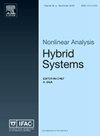Closure certificates
IF 3.7
2区 计算机科学
Q2 AUTOMATION & CONTROL SYSTEMS
引用次数: 0
Abstract
A barrier certificate, defined over the states of a dynamical system, is a real-valued function whose zero level set characterizes an inductively verifiable state invariant separating reachable states from unsafe ones. When combined with powerful decision procedures — such as sum-of-squares programming (SOS) or satisfiability-modulo-theory solvers (SMT) — barrier certificates enable an automated deductive verification approach to safety. The barrier certificate approach has been extended to refute LTL and -regular specifications by separating consecutive transitions of corresponding -automata in the hope of denying all accepting runs. Unsurprisingly, such tactics are bound to be conservative as refutation of recurrence properties requires reasoning about ranking functions to prove liveness as well. This paper introduces the notion of closure certificates as a natural extension of barrier certificates from state invariants to transition invariants. We show how one may use ranking function arguments over such certificates to verify discrete-time dynamical systems against Linear Temporal logic formulae. We augment these definitions with SOS and SMT based characterization for automating the search of closure certificates and demonstrate their effectiveness over some case studies.
关闭证书
屏障证书是定义在动态系统状态上的实值函数,它的零水平集刻画了一个归纳可验证的状态不变量,将可达状态与不安全状态分离开来。当与强大的决策程序(如平方和编程(SOS)或可满足模理论解算器(SMT))相结合时,屏障证书可以实现自动演绎验证安全方法。将屏障证书方法扩展到驳斥LTL和ω-正则规范,通过分离相应ω-自动机的连续转换,希望拒绝所有接受运行。不出所料,这种策略必然是保守的,因为要反驳递归性,还需要对排序函数进行推理,以证明其活动性。本文介绍了闭包证书的概念,作为屏障证书从状态不变量到转换不变量的自然扩展。我们展示了如何在这些证书上使用排序函数参数来验证离散时间动力系统与线性时间逻辑公式的关系。我们使用基于SOS和SMT的特征来扩展这些定义,以实现关闭证书的自动搜索,并通过一些案例研究证明了它们的有效性。
本文章由计算机程序翻译,如有差异,请以英文原文为准。
求助全文
约1分钟内获得全文
求助全文
来源期刊

Nonlinear Analysis-Hybrid Systems
AUTOMATION & CONTROL SYSTEMS-MATHEMATICS, APPLIED
CiteScore
8.30
自引率
9.50%
发文量
65
审稿时长
>12 weeks
期刊介绍:
Nonlinear Analysis: Hybrid Systems welcomes all important research and expository papers in any discipline. Papers that are principally concerned with the theory of hybrid systems should contain significant results indicating relevant applications. Papers that emphasize applications should consist of important real world models and illuminating techniques. Papers that interrelate various aspects of hybrid systems will be most welcome.
 求助内容:
求助内容: 应助结果提醒方式:
应助结果提醒方式:


